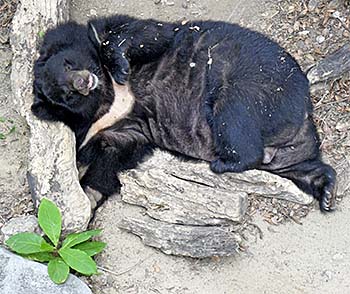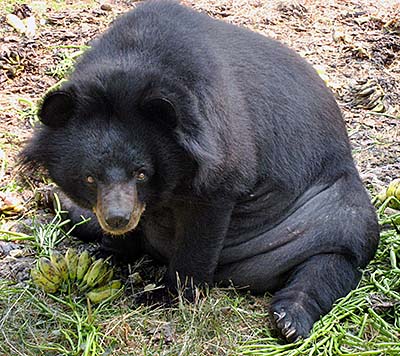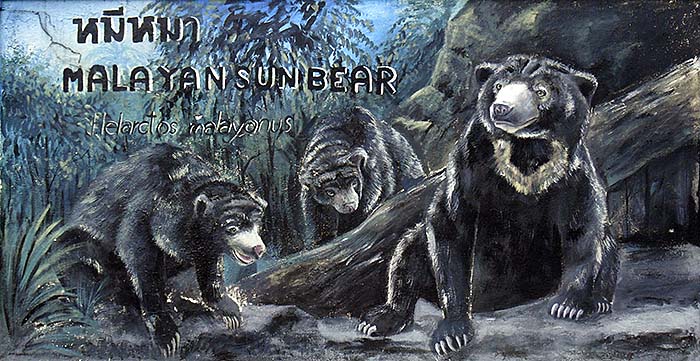1.
Sun Bear
The Malayan Sun Bear appeared originally all over Southeast Asia northwest of the Wallace Line, except in the Philippines. His habitat stretched deep into south China and into east India. Now, due to the massive deforestation in Southeast Asia, habitat loss made the Malayan Sun Bear an endangered species.

A Malayan Sun Bear, having an afternoon nap in Dusit Zoo, Bangkok. Image by Asienreisender, 5/2012
The typical habitat of the larger animals, who are sometimes also called 'honeybears', are the tropical rainforests and the half-dry forests of semi-tropical regions. There they appear from the lowlands up to altitudes of more than 2,000m. They also live in mangrove forests and swamplands.
Sun bears are the smallest kind of bear. Their weight is between 30kg to 80kg; males are clearly heavier and larger than females. A grown-up reaches about 1.20m to 1.50m in length. Their tails are short stumps of three to seven centimeters.
Malayan Sun Bears are nocturnal, at daytime they sleep in trees where they build nests from branches a couple of meters above the ground. They also squat under fallen trees or in hollow trunks or under large roots. Like all bears they live solitair. Unlike the bears in the northern hemisphere, they hold no winter sleep. When being surprised in the forest, they can become pretty aggressive.

A Malayan Sun Bear, seen in Lopburi Zoo, Thailand. Image by Asienreisender, 2/2007
The bears diet consists mainly of insects and vertebrates. They rip tree barks off with their paws and teeth, who are long and have a strong bite power, to get access to insects. They also like to plunder beehives. They do put their claws into termite nests to lure the termites on their paws to lick them up. Their tongue is a sophisticated tools of the length of about 25cm. Additionally they eat fruit and smaller lizards, birds and rodents. Here and there they scavenge on carcasses. They also go into plantations like coconut plantations and can cause damage there, what makes plantation owners to hunt them for.
Malayan Sun Bears can breed all over the year; they get usually one or two babies, who are born blind an helpless and stay with their mother until being adult. Pubescence is reached after three years. Their lifespan can extend thirty years.
Massive habitat loss due to deforestation particularly in the last thirty years made the bears, like many other animals, very vulnerable (See also the article of forest fires in Southeast Asia). A great part of the population died already, the rest lives merely in patches of it's former range. In many countries some of their body parts are believed to have certain healing powers. Bear gall is just one example. Therefore they get hunted or bred and later butchered. Chinese so called 'medicine', in fact nothing but savage superstition, plays a very evil role here. Bear meat is used as a food source for many people in Kalimantan. The same is true for many other animals. Sun bears can be kept as pets as well. There is a market for that in Southeast Asia; unfortunately many of the bears in captivity are kept in poor conditions and the animals suffer deprivation.
There are, except homo sapiens, practically no real natural enemies of the sun bear. There is one reported case of a python who killed a bear after approaching the sleeping animal.

Three Malayan Sun Bears on a painting at the outer walls of Dusit Zoo in Bangkok. It's probably a mother with her adolescent cubs. A fallen trunk serves as a hideout for the animals. Image by Asienreisender, 5/2012